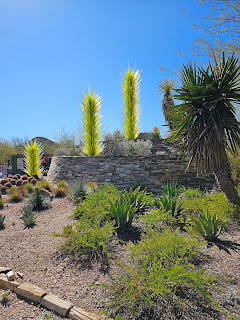Desert Botanical Garden
Baskets
(Picture is Banana Yucca)
The Akimel O’odham
weave cattail leaves, split reeds, cottonwood splints, devil’s claw and banana
yucca roots to make baskets and mats.
The western
Apache make large baskets from sumac, willow, cottonwood trees and other
plants. Mesquite pit can be used for waterproofing.
People use
the roots and stems of grasses to make brooms, hairbrushes, and baskets. They
also use these plants as fuel and for thatching. People traditionally living in
the desert often traveled to nearby grasslands to gather plants and hunt
animals seasonally.
Akimel O’odham
Household
Traditional
Akimel O’odham households usually have more than one structure, each with a special
function. The roundhouse (olas kih) provides privacy, shelter, storage space
and a place to sleep. The kitchen (ko:sin), which has no roof, allows heat from
cooking to dissipate quickly. The ramada (vatto) provides shade for outdoor
activities.
Traditional
Akimel O’odham Kitchen (Ko:sin)
The Akimel O’odham
ko:sin has a low circular wall made of thatched arrowhead that acts as a wind
block and provides shade. Mesquite trees are the preferred fuel source or
cooking fires, but ironwood, palo verde and cottonwood trees are used as well.
Akimel O’odham
Ramada (Vatto)
The vatto is
the focus of many daily activities. This shaded shelter without walls is an
ideal place to eat, sleep and cook food in the desert. Since airflow is
unrestricted it stays much cooler than the real temperature.
The roof is
made of thick layers of arrowweed branches and supported by mesquite poles. The
rafters in the roof provide a cool place to store grain and other foods.
Mesquite
Bosque
Densely
packed mesquite trees provide large areas of shelter in this habitat. These
bosques (Spanish for small forest), thrive near desert rivers or where their
long roots can reach ground water.
The mesquite tree is one of the most important plants for people living in the Sonoran Desert. Providing food, shelter, medicine, fiber and dye, the mesquite is referred to as the tree of life.
Three
Sisters Planting
For
centuries many Native America communities have planted three particular crops
together in a way that helps each one thrive and survive. Known as the Three
Sisters, maize (corn), beans and squash create a balanced diet and they also
help each other to grow. Tall corn acts as a pole for bean vines to climb,
beans add nitrogen to the soil and large squash leaves create shade and protect
all three plants from weeds.
Garden
visitors often ask why Gambel's quail have those curious-looking plumes on
their heads that are especially prominent on the males. Composed of six black,
comma-shaped feathers that tightly overlap, you might guess that this topknot's
function is to impress. The
Sonoran desert is home to this distinctive bird.
Why does the
Palo Verde Tree have green bark? Photosynthesis is the process that plants use
to make their own food. The green bark allows the palo verde tree to make its own
food even when the leaves fall off. Plants are the only organisms that make their
own food. All animals, including humans, obtain nutrients from plants or from
animals that eat plants. Without plants, there would be no animal life on
earth.
Agave
Roasting Pit
For
centuries, agave has been roasted for food and fibers in pits like this by
people in the Sonoran Desert. Before roasting, the leaves are removed to expose
the heart. Agave hearts are then sandwiched between layers of vegetation on top
of hot coals and the hearts are bakes for up to four days. Almost all the agave
plant can be cooked and eaten including the leaves, flowers, stalks, blossoms
and seeds.




















































1 comment:
Beautiful pictures! I'll be sure to show Cashton the sundial.
Post a Comment